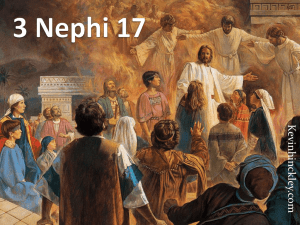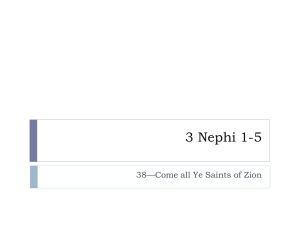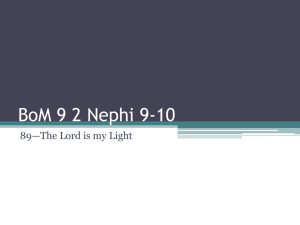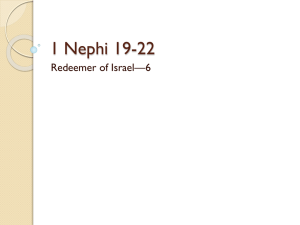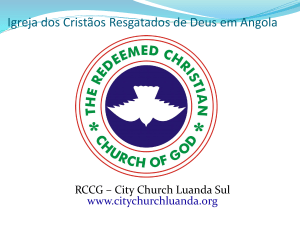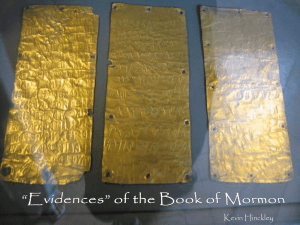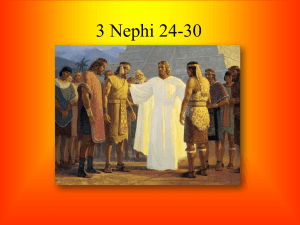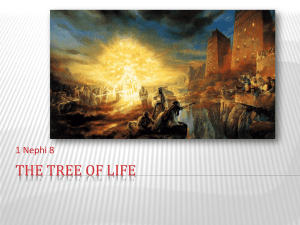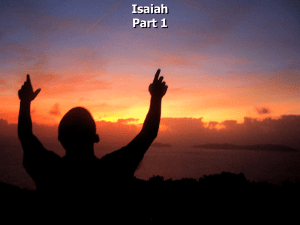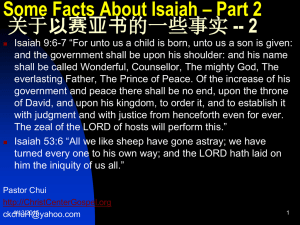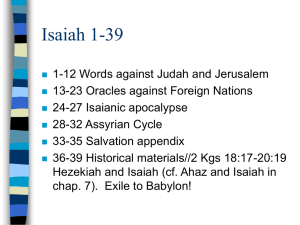2 Nephi 11-16
advertisement
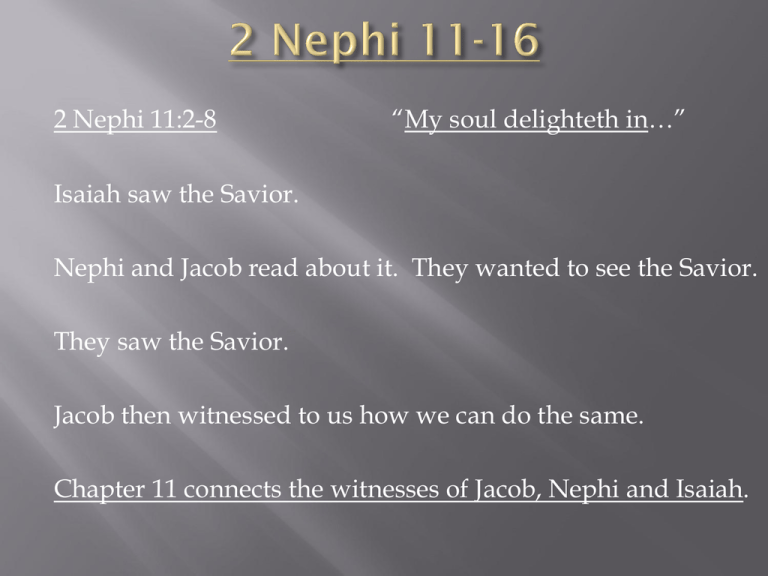
2 Nephi 11:2-8 “My soul delighteth in…” Isaiah saw the Savior. Nephi and Jacob read about it. They wanted to see the Savior. They saw the Savior. Jacob then witnessed to us how we can do the same. Chapter 11 connects the witnesses of Jacob, Nephi and Isaiah. Isaiah is quoted more often in the New Testament, Book of Mormon, Doctrine and Covenants, and contemporary documents such as the Dead Sea Scrolls than any other Old World prophet” (Jeffrey R. Holland, Christ and the New Covenant, 75-76). If the Isaiah verses in the Book of Mormon were removed from their present position and collected into one book, that book would contain 592 verses --- more than are found in twelve of the fifteen books in the Book of Mormon. It would be the fourth largest book in the Book of Mormon. Isaiah is by every standard the messianic prophet of the Old Testament and as such is the most penetrating prophetic voice in that record. A useful footnote to 2 Nephi 12:2 in the current edition of the LDS scriptures indicates that some 433 verses of Isaiah --roughly a third of the entire book ---are quoted in the Book of Mormon. One student of Isaiah documents that no less than 391 of those verses refer to the attributes, appearance, majesty, and mission of Jesus Christ. Another scholar has pointed out that Isaiah provided at least sixty-one names and titles of the Father and of the Son in his writings, most of those referring to some aspect of the mission of Christ. Isaiah sees the Savior and records it. Nephi reads Isaiah’s record of seeing the Savior. He desires the same witness and then sees the Savior. Nephi told us about his experience and taught us that we can have the same experience. 1. He himself delighted in his words and proving truth (2 Nephi 11:2). 2. To prove the truthfulness of Christ (2 Nephi 11:4, 6). 3. So the reader may lift up their heart and rejoice. Three Major time periods: 1. Isaiah’s day 2. The Savior’s day 3. The Latter-days Sidney B. Sperry wrote: The text of Isaiah in the Book of Mormon is not word for word the same as that of the King James version. Of 433 verses of Isaiah in the Nephite record, Joseph Smith modified about 233. Some of the changes made were slight, others were radical. However 199 verses are word for word the same as the old English version. We therefore freely admit that Joseph Smith may have used the King James version when he came to the text of Isaiah in the gold plates. As long as the familiar version agreed substantially with the text on the gold plates (taken from the brass plates), he let it pass; when it differed too radically he translated the Nephite version and dictated the necessary changes (92). The version of Isaiah in the Nephite scripture hews an independent course for itself, as might be expected of a truly ancient and authentic record. It makes no additions to the present text in certain places, omits material in others, transposes, makes grammatical changes, finds support at times for its unusual readings in the ancient Greek, Syriac, and Latin versions, and at other times no support at all. In general, it presents phenomena of great interest to the student of Isaiah (97). Because of space limitations in the Book of Mormon footnotes, much of the footnote information concerning Isaiah is only in the Bible footnotes and was not repeated in the Book of Mormon footnotes. Therefore, to study 2 Nephi 12-24 and help in your understanding of Isaiah, use the LDS Bible footnotes for Isaiah 2-14. “You, too, may be tempted to stop there, but do not do it! Do not stop reading! Move forward through those difficult-to-understand chapters of Old Testament prophecy, even if you understand very little of it. Move on, if all you do is skim and merely glean an impression here and there. Move on, if all you do is look at the words” (C.R., Apr. 1986, 76). 2 Nephi 11:5 “Deliverance from Death” The Prophet Joseph Smith declared: “The fundamental principles of our religion are the testimony of the Apostles and Prophets, concerning Jesus Christ, that He died, was buried, and rose again the third day, and ascended unto heaven; and all other things which pertain to our religion are only appendages to it” (Teachings, 121). The Isaiah portions in the Book of Mormon underscore four major themes: 1. The judgments of God and needed repentance. 2. The covenants of God and His promises to the house of Israel. 3. Christ’s first and second coming. 4. Major events relating to the latter days. The Bible Dictionary observes: “Isaiah is the most quoted of all the prophets, being more frequently quoted by Jesus, Paul, Peter, and John (in his Revelation) than any other [Old Testament] prophet. Likewise the Book of Mormon and the Doctrine and Covenants quote from Isaiah more than any other prophet. The Lord told the Nephites that ‘great are the words of Isaiah,’ and that all things Isaiah spoke of the house of Israel and of the gentiles would be fulfilled (3 Nephi 23:1-3) (Bible Dictionary, Isaiah, 707). Isaiah wrote a little over 100 years before Nephi’s time (740-700 B.C.). While the writings seem quite distant form our day, for Nephi and Jacob, they were closer than the revelations and prophecies of Joseph Smith are for modern readers. The reader today has no greater written commentary and guide to understanding Isaiah than the Book of Mormon and the Doctrine and Covenants. 2 Nephi 12:2 “The Lord’s house shall be established in the top of the mountains.” It has specific reference to the Salt Lake Temple and to the other temples built in the top of the Rocky Mountains, and it has a general reference to the temple yet to be built in the New Jerusalem in Jackson County, Missouri” (Bruce R. McConkie, New Witness for the Articles of Faith, 539-40). The word mountain is used in the scriptures in different allegorical or figurative senses. The word mountain refers to a high place of God, a place of revelation, even the temple of the Lord. “This temple (Salt Lake Temple) on this temple block is that house of God of Jacob that our pioneer fathers started to build when they were a thousand miles from transportation, and it took them forty years to build it” (LeGrand Richards, C.R., Oct. 1975, 77). 2 Nephi 12:3 “Out of Zion Shall Go Forth the Law, and the Word of the Lord from Jerusalem.” President Hinckley remarked: “As I contemplate this marvelous structure adjacent to the temple [the Conference Center], I believe that prophecy applies to the historic and wonderful Salt Lake Temple. But I believe also that it is related to this magnificent hall. For it is from this pulpit that the law of God shall go forth, together with the word and testimony of the Lord” (C.R., Oct. 2000, 89). 2 Nephi 12:20 Why will the wicked cast their gold and silver “to the moles and to the bats?” “The imagery of verse twenty is striking: the people will throw their gold and silver to moles and bats, animals who are blind…The irony of this is that people who understood the material value of the precious metals, and should also have seen the spiritual impotence of the idols, will throw these precious items to animals who will not be able to see them at all” (Victor L. Ludlow, Isaiah: Prophet, Seer, and Poet, 92). Success with Isaiah 2 Nephi 12-15 2 Nephi 12:2 Salt Lake Temple and the Conference Center. 2 Nephi 12:7 Military Power, but not the Lord’s. 2 Nephi 12:8 Idolatry, Men worshipping the work of their own hands. 2 Nephi 12:9 The “mean man” (common) has nothing, the “great man” no humility. 2 Nephi 12:11-22 Men and women will be humbled at the 2nd Coming. 2 Nephi 13:5 Loss of respect for the elderly. 2 Nephi 13:9-11 Wickedness shows in our faces. Sin of homosexuality will be a problem and will lead to many deaths. Jeremiah wrote that the people had become so sinful that they lost their ability to blush (Jeremiah 6:15). 2 Nephi 13:12 Rebellious children, women who become like men. 2 Nephi 13:16 Women who become vain and immoral. 2 Nephi 13:18-23 Clothing and worldly things become the most important to men and women. 2 Nephi 13:16-23 Who are the “daughters of Zion” described in these verses? There are at least two interpretations for who the “daughters of Zion” represent. First, these verses are a physical description of members in the last days. “It is,…a sad reflection on the ‘daughters of Zion’ when they dress immodestly. Moreover, this remark pertains to the men as well as to the women” (Joseph Fielding Smith, Answers to Gospel Questions, 5:174). Second, these “daughters of Zion” could represent those members of the Church that have accepted the baptismal covenant and later forsake their vows and turn to the gods of men. 2 Nephi 13:24-26 How are these verses descriptive of the results of war? “There shall be stink” (v. 24) The stench of dead bodies will sicken the air. “A rent” (v. 24) Clothing ripped or torn, like rags. “Baldness” (v. 24) Shaving heads and beards was a symbol of captivity. “Sackcloth” (v. 24) A coarse, dark cloth made of goat or camel hair. “Burning” (v. 24) Branding, another symbol of captivity. “Sit upon the ground” (v. 26) A posture of mourning. (Adapted from Hoyt W. Brewster Jr., Isaiah Plain & Simple, 3334) 2 Nephi 13:1-11 “Punished as a Result of Wickedness” Isaiah foresaw that Judah and Jerusalem would be punished by the Lord as a result of their wickedness. In 587 B.C. the city of Jerusalem was destroyed, and Judah was taken into captivity by Nebuchadnezzar, king of Babylon. In A.D. 70, 657 years later, the Romans destroyed Jerusalem and scattered the Jews to various portions of the world. Surely they had, as Isaiah said, “rewarded evil unto themselves” (2 Nephi 13:9). 2 Nephi 14:1 Seven women take hold of one man. Without husband, children, or family. No forever family. 2 Nephi 15:8 Tract housing, apartments, no space for yards or gardens. 2 Nephi 15:9 War that causes cities to be desolate and without people. 2 Nephi 15:11 Alcoholism! One of the greatest plagues of our country. 2 Nephi 15:12 Music and wine more important than the work of the Lord. 2 Nephi 15:18 Tied to their sins like a beast to their cart. 2 Nephi 15:19 People will say, “Christ will not come again.” 2 Nephi 15:20 Call evil good and good evil. 2 Nephi 15:22 Beer commercials? 2 Nephi 15:26-28 Modern transportation? 2 Nephi 15:26 Missionaries to the four corners? 2 Nephi 15:18, 20-21 “Warnings against Sin” President Harold B. Lee described how sin is like a burden: “If I were to ask you what is the heaviest burden one may have to bear in this life, what would you answer? The heaviest burden that one has to bear in this life is the burden of sin” (C.R., Apr. 1973, 177). President James E. Faust said, “The gap between what is popular and what is righteous is widening. Revelations from the prophets of God are not like offerings at the cafeteria, some to be selected and others disregarded” (C.R., Oct. 2003, 21). 2 Nephi 15:26-30 “In fixing the time of the great gathering, Isaiah seemed to indicate that it would take place in the day of the railroad and the airplane (Isaiah 5:26-29). “Since there was neither trains nor airplanes in that day, Isaiah could hardly have mentioned them by name. However, he seems to have described them in unmistakable words. How better could ‘their horses’ hoofs be counted like flint, and their wheels like a whirlwind’ than in the modern train? How better could ‘their roaring…be like a lion’ than in the roar of the airplane? Trains and airplanes do not stop for night. Therefore, was not Isaiah justified saying: ‘none shall slumber nor sleep, neither shall the girdle of their loins be loosed, not the latchet of their shoes be broken?’ With this manner of transportation the Lord can really ‘hiss unto them from the end of the earth,’ that they shall come with speed swiftly,’ Indicating that Isaiah must have foreseen the airplane, he stated: ‘Who are these that fly as a cloud, and as the doves to their windows?’ (Isaiah 60:8) (LeGrand Richards, Israel! Do You Know?, 182). Remember, Isaiah is a poet! Remember, Christ is the temple! v.1 “Train” = Followers v.2 “Seraphim = Angels who reside in the presence of God “Wings” = Power to move “Covered his face and his feet” = temple clothing v.3 “the whole earth is full of His glory Members = v. 4 “filled with smoke” symbolic of the presence of God v. 5 “I am undone” without hope, unclean v. 6 “Coal” Atonement, purifying, cleansing v. 8 “Here am I; send me I am clean, now I can go and serve. “Unclean Lips” 2 Nephi 16:13 Nephi used the prophecies of Isaiah to teach his people of the need to rely upon the Lord and look to him who would preserve them. Isaiah’s prophecies of the coming of the Messiah in the lineage of Judah were an assurance that their nation would not be totally destroyed, though they would suffer because of their sins. As the Lord would punish the nations of Assyria and Babylon for opposing his people, he would also overthrow all the wicked in the end and would establish Zion. The early prophets of the Book of Mormon frequently quoted from the writings of Isaiah which appeared on the Brass Plates of Laban (I Nephi 5:1113; 19:21-23). Of the 433 verses of Isaiah quoted in the Book of Mormon, 199 verses are word for word the same as the corresponding verses in the King James Version of the Old Testament. The so called Isaiah problem is this: How do Latter-day Saints account for this striking similarity in nearly half of the verses and the differences in the remainder of the verses? In order to attempt an explanation of this problem, a person should consider the following points. Joseph Smith did not explain in great detail the process used in translating the Book of Mormon; he merely stated, “through the medium of the Urim and Thummim I translated the record by the gift and power of God” (Millennial Star Vol. 18, 118). However, it is quite evident that the process of translation was not automatic; Joseph Smith not only had to exercise faith in the translation procedure, but he also had to put forth mental and spiritual effort. (If you desire additional information on this point, see B.H. Roberts’ New Witness for God 11:130-146). Oliver Cowdery’s unsuccessful attempt to translate indicates clearly that the translation of the Book of Mormon was more than a mechanical process (D&C 8:1-3, 10, 11; 9:7-9). Also, translation is frequently concerned with general ideas rather than specific words; even the best translators do not translate the same material from one language into another word for word the same. Thus there appears to be only one answer to explain the word for word similarities between the verses of Isaiah in the Bible and the same verses in the Book of Mormon. When Joseph Smith translated the Isaiah references from the small plates of Nephi, he evidently opened his King James Version of the Bible and compared the impression he had received in translating with the words of the King James scholars. If his translation was essentially the same as that of the King James Version, Joseph Smith apparently quoted the verse from the Bible; then his scribe, Oliver Cowdery, copied it down. However, if Joseph Smith’s translation did not agree precisely with that of the King James scholars, he would dictate his own translation to the scribe. This procedure in translation would account both for the 234 verses of Isaiah which were changed or modified by the Prophet Joseph Smith as well as the 199 verses which were translated word for word the same. Although some critics might question this procedure of translation, scholars today frequently use this same procedure in translating the Biblical manuscripts among the Dead Sea Scrolls (A Companion to Your Study of the Book of Mormon, 4344).
